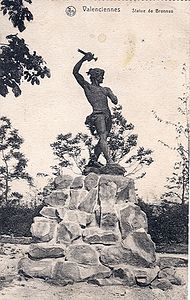German occupation of north-east France during World War I
The German occupation of France during World War I refers to the period in which French territory, mostly along the Belgian and Luxembourgish border, was held under military occupation by the German Empire during World War I.
This entailed various impositions on the population, including malnourishment, forced labor, and requisitions of property, services, and goods.
The territory occupied by Germany at the end of 1914 included 10 départements in part or in full, including ː
These territories constituted 3.7% of the area and 8.2% of the population of France itself (about 2 million inhabitants).
The current departments of Bas-Rhin, Haut-Rhin, and Moselle, which were part of the German Reich from 1871 until their return to France at the end of the war in November 1918, are not included in this territory.[1]
The vast majority of the territory of neighboring Belgium was also occupied, with the exception of the western part of maritime Flanders, around Ypres. However, the Franco-Belgian border was maintained and the crossings controlled.
Part of Picardy was temporarily liberated in 1917 but the border area remained under German domination for four years: Lille for 1,465 days, Laon for 1,502 days, and Roubaix from October 14, 1914, to October 17, 1918.[2]
The occupied zone remained under military administration but some territories were assigned a particular status. The northern part of the valley of the Meuse River (including Givet and Fumay) was attached to the General Government of Belgium; the district of Briey was placed under German civil authority until December 1916, and then the military governor of Metz. The population of this area greatly decreased during this period due to both the excessive mortality relative to births as well as deportations and voluntary migration to unoccupied France. Thus, the department of the Ardennes, which had 319,000 inhabitants before the war, counted only 175,000 at the time of liberation; the population of Lille fell from 217,000 inhabitants at the beginning of 1914 to 112,000 in October 1918; and that of Roubaix from 122,723 to 77,824; while Tourcoing's population fell from 82,644 to 58,674. Some localities near the front and some towns in the Ardennes were emptied of the majority of their population. At the end of the war, Rethel had only 1,600 inhabitants, compared to 5,187 in 1911.[3]
For the whole of the occupied territory, the statistics of the Food Committee of the North of France indicate 2,235,467 inhabitants in 1915, but only 1,663,340 as of June 30, 1918; the decrease over the entire period beginning in the autumn of 1914 was undoubtedly significantly higher.[4]
The majority of the population was made up of women, children and the elderly, most of the men having been mobilized.
Acts of resistance[edit]
The resistance to the German occupation was evident in gradations; from passive resistance, such as indifference displayed towards the occupier, refusal to come into contact; to daily resistance such as opposition to requisitions and forced labor, aid to prisoners (provision of food), all acts punished with imprisonment; to the most active and risky actions of resistance, such as sabotage of railway tracks, aid to soldiers, organization of escape networks, publishing and distribution of the underground press (with low circulation, in the best of cases several hundred, sometimes limited to a few copies, in particular the newspaper Patience, which changed its name several times and whose group was dismantled by the Germans in 1916), until the collection of military intelligence communicated to the allies, activity organized in networks, the best known being those of Jacquet, Trulin and Louise de Bettignies.[34]
In popular culture[edit]
Much of the 1928 novel Schlump by Hans Herbert Grimm is set in German-occupied France where the protagonist works in the occupation administration.
The Alice Network is a 2017 novel about a real allied spy ring of the same name, set set in Lille.[41]






